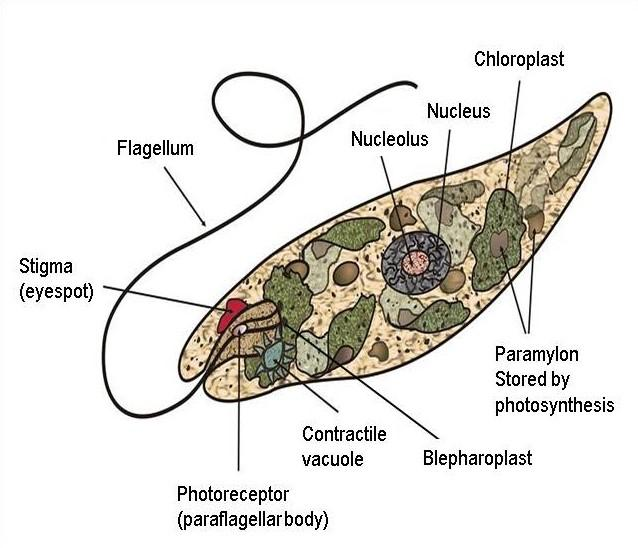
Answer
401.4k+ views
Hint: It is a eukaryotic organism that exhibits features of both animal and plant. That is why it is called a link between plants and animals.
Complete Answer:
- Euglena is a unicellular eukaryotic organism. The cell body is elongated and uninucleated i.e. having one nucleus. The cell wall is absent. Instead, a proteinaceous layer is present which is known as pellicle. The pellicle is composed of overlapping and interlocking strips that are wrapped around the cell in a spiral manner.
- This arrangement of pellicular strips contributes flexibility to the cell. Sliding of these strips along one another results in the movement of the cell. Due to these strips the cell becomes able to contract and change its shape.
- The plasma membrane is thin and encloses the cytoplasm and all cell organelles. The anterior end of the cell has a flask shaped reservoir with a small opening known as cytostome. One or more contractile vacuoles are present which functions to remove the extra water.
- Euglena has two flagella that arise from the blepharoplast located at the base of the reservoir. Typically, one flagellum is long and projects out from the cell whereas; other flagellum is very short and does not emerge from the reservoir.
- The flagellum helps the organism in swimming. A prominent red coloured eye spot or stigma is present. The red colour of stigma is due to the presence of reddish carotenoid pigment granules. It is a light perceiving organ. It helps the organism to find the light and move towards it.

Fig: Cellular organisation of Euglena
- The chloroplasts are present along with other cell organelles such as golgi bodies, mitochondria, endoplasmic reticulum etc. Different photosynthetic pigments like chlorophyll a, chlorophyll b, xanthophylls and beta carotene are present in the chloroplast.
- Euglena chloroplasts also possess pyrenoids that are the centres for paramylon synthesis.
In the presence of sufficient sunlight, the organism uses chlorophyll pigments to produce sugars by photosynthesis. But they are not fully autotrophic.
- Rather these are photoautotrophs because they require some organic nutrients and vitamins to perform photosynthesis. When light is not available they become heterotrophic. The property of being a photosynthetic organism as well as a facultative heterotroph makes Euglena a unique organism.
Note: Euglena survives best in stagnant waters like ponds and lakes. In certain cases, Euglena gives red colouration to water due to increase in astaxanthin, a characteristic euglenoid xanthophyll pigment.
Complete Answer:
- Euglena is a unicellular eukaryotic organism. The cell body is elongated and uninucleated i.e. having one nucleus. The cell wall is absent. Instead, a proteinaceous layer is present which is known as pellicle. The pellicle is composed of overlapping and interlocking strips that are wrapped around the cell in a spiral manner.
- This arrangement of pellicular strips contributes flexibility to the cell. Sliding of these strips along one another results in the movement of the cell. Due to these strips the cell becomes able to contract and change its shape.
- The plasma membrane is thin and encloses the cytoplasm and all cell organelles. The anterior end of the cell has a flask shaped reservoir with a small opening known as cytostome. One or more contractile vacuoles are present which functions to remove the extra water.
- Euglena has two flagella that arise from the blepharoplast located at the base of the reservoir. Typically, one flagellum is long and projects out from the cell whereas; other flagellum is very short and does not emerge from the reservoir.
- The flagellum helps the organism in swimming. A prominent red coloured eye spot or stigma is present. The red colour of stigma is due to the presence of reddish carotenoid pigment granules. It is a light perceiving organ. It helps the organism to find the light and move towards it.

Fig: Cellular organisation of Euglena
- The chloroplasts are present along with other cell organelles such as golgi bodies, mitochondria, endoplasmic reticulum etc. Different photosynthetic pigments like chlorophyll a, chlorophyll b, xanthophylls and beta carotene are present in the chloroplast.
- Euglena chloroplasts also possess pyrenoids that are the centres for paramylon synthesis.
In the presence of sufficient sunlight, the organism uses chlorophyll pigments to produce sugars by photosynthesis. But they are not fully autotrophic.
- Rather these are photoautotrophs because they require some organic nutrients and vitamins to perform photosynthesis. When light is not available they become heterotrophic. The property of being a photosynthetic organism as well as a facultative heterotroph makes Euglena a unique organism.
Note: Euglena survives best in stagnant waters like ponds and lakes. In certain cases, Euglena gives red colouration to water due to increase in astaxanthin, a characteristic euglenoid xanthophyll pigment.
Recently Updated Pages
Write the IUPAC name of the given compound class 11 chemistry CBSE

Write the IUPAC name of the given compound class 11 chemistry CBSE

Write the IUPAC name of the given compound class 11 chemistry CBSE

Write the IUPAC name of the given compound class 11 chemistry CBSE

Write the IUPAC name of the given compound class 11 chemistry CBSE

Write the IUPAC name of the given compound class 11 chemistry CBSE

Trending doubts
Fill the blanks with the suitable prepositions 1 The class 9 english CBSE

Which are the Top 10 Largest Countries of the World?

How do you graph the function fx 4x class 9 maths CBSE

Distinguish between the following Ferrous and nonferrous class 9 social science CBSE

The term ISWM refers to A Integrated Solid Waste Machine class 10 social science CBSE

The Equation xxx + 2 is Satisfied when x is Equal to Class 10 Maths

Difference between Prokaryotic cell and Eukaryotic class 11 biology CBSE

Which is the longest day and shortest night in the class 11 sst CBSE

In a democracy the final decisionmaking power rests class 11 social science CBSE




